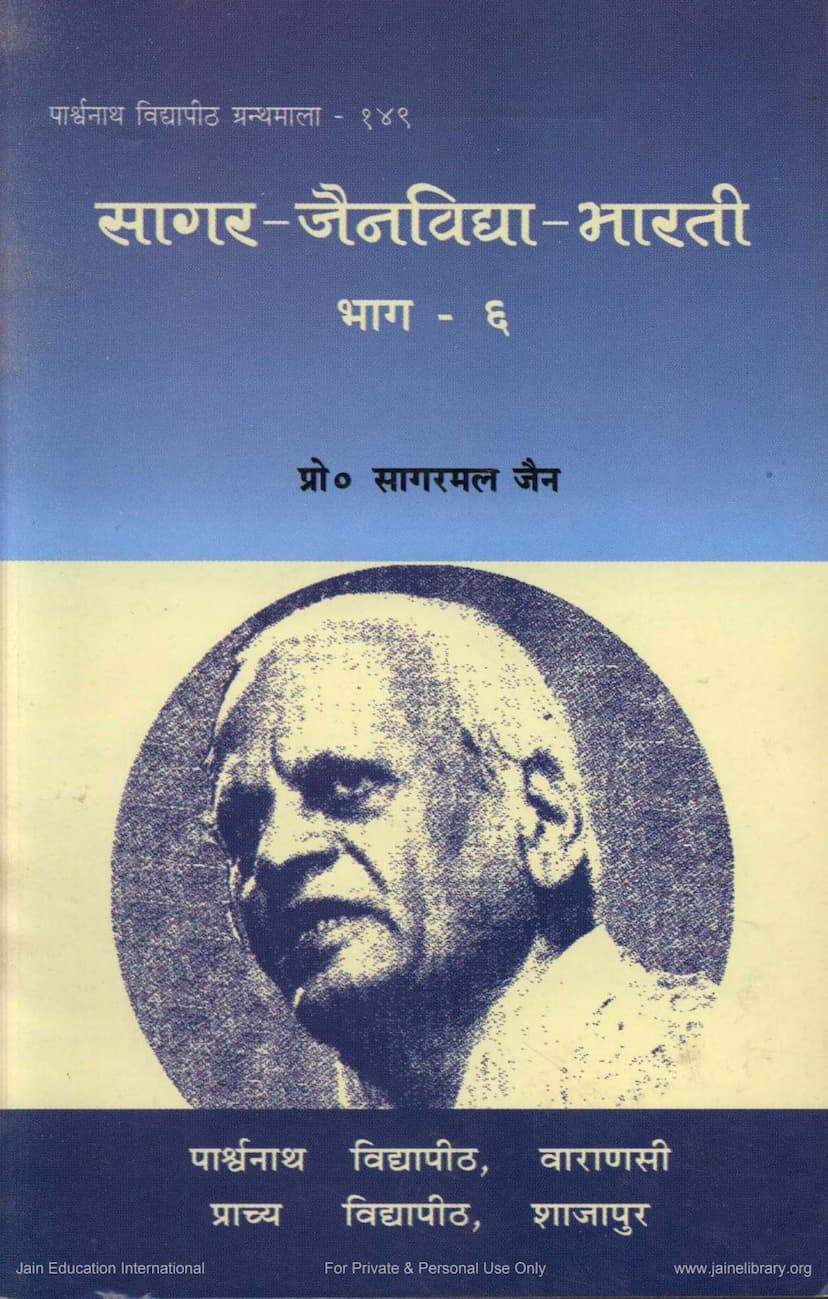Sagar Jain Vidya Bharti Part 6
Added to library: September 2, 2025

Summary
Here's a comprehensive summary of "Sagar Jain Vidya Bharti Part 6" by Prof. Sagarmal Jain, based on the provided text:
Book Title: Sagar Jain Vidya Bharti Part 6 Author: Prof. Sagarmal Jain Publisher: Parshwanath Shodhpith, Varanasi Edition: First Edition, 2006
This volume is the sixth installment in the "Sagar Jain Vidya Bharti" series, a compilation of research articles by the esteemed scholar Prof. Sagarmal Jain, a noted researcher in Shraman culture. The book is dedicated to the distinguished scholar of Prakrit studies, the late Prof. K.R. Chandra.
The book comprises a collection of Prof. Jain's significant essays covering various dimensions of Jain philosophy, literature, ethics, history, culture, and art. Through these essays, readers can gain insight into the depth of his knowledge, his critical perspective, and his excellent writing style.
Key Themes and Articles Covered (as per the Index):
The book is divided into two sections: Hindi and English.
Hindi Section:
The Hindi section features 22 articles, delving into diverse aspects of Indian culture and Jainism:
- Interrelation of two major components of Indian culture (Vedic and Shraman): This foundational article explores the deep connection and mutual influences between the Vedic and Shraman streams of Indian culture, analyzing their respective emphasis on worldly pursuits (pravritti) versus renunciation (nivritti) and how they eventually integrated.
- Mahavira's Shravaka community then and now: A self-analysis: This essay examines the role and significance of the lay followers (Shravakas) of Lord Mahavira, reflecting on their commitment and contribution to Jainism both in Mahavira's time and in the present day, highlighting a potential shift in their influence from character-strength to wealth and power.
- Birthplace of Lord Mahavira: A reconsideration: This article critically re-evaluates the traditional claims about Lord Mahavira's birthplace, examining historical and textual evidence to present a reasoned argument for its location.
- Kevalgyana Sthal of Lord Mahavira: A reconsideration: Similar to the birthplace article, this essay revisits and critically analyzes the location of Lord Mahavira's attainment of omniscience (Kevalgyana).
- Nirvana Bhumi of Lord Mahavira, Pava - A reconsideration: This article focuses on the site of Lord Mahavira's final liberation (Nirvana), Pava, and critically examines different historical and traditional perspectives on its exact location.
- The evolutionary journey of Jain metaphysics: In historical perspective: This essay traces the development of core Jain metaphysical concepts, such as Pañcāstikāya, ṣaḍdravya, ṣaḍjīvanikāya, and the concept of nine/seven tattvas, within a historical context.
- The concept of Moksha (Liberation) in Jain Philosophy: This article discusses the Jain understanding of liberation, its nature, and the path to achieve it.
- The ancient form of Jin Pratima: A critical reflection: This essay critically examines the historical evolution and characteristics of images of Jinas (Jain Tirthankaras), analyzing their sculptural styles and iconography.
- The ancient form of Jain Mantras in 'Angavidya': This article explores the presence and significance of Jain mantras within the ancient text 'Angavidya', discussing their early forms and their connection to Jain tantric practices.
- Umaswati and the origin and area of movement of his Uchchhai-gar branch: This essay investigates the origins of the Uchchhai-gar school to which Umaswati, the author of Tattvarthasutra, belonged, and analyzes his geographical sphere of activity.
- The era of Umaswati: This article attempts to determine the historical period of Umaswati based on textual and other evidence.
- Umaswati and his tradition: This essay delves into the lineage and philosophical tradition associated with Umaswati.
- Shravasti in Jain Agam Literature: This article examines the references to the city of Shravasti in Jain canonical texts, highlighting its historical and religious significance.
- Krishna in Prakrit and Apabhramsha Jain Literature: This essay explores the portrayal of Lord Krishna in Jain literature written in Prakrit and Apabhramsha, analyzing how his character was adapted and integrated into the Jain narrative.
- Mulachara: A study: This article provides a detailed study of the 'Mulachara,' a significant text on monastic conduct in Jainism.
- Presentation and critique of Charvaka Philosophy in ancient Jain Agamas: This essay analyzes how the materialistic Charvaka philosophy is presented and critiqued within early Jain canonical texts.
- Charvaka Philosophy presented in Rishi Bhashita: This article specifically focuses on the depiction of Charvaka philosophy in the 'Rishi Bhashita' text.
- Presentation and critique of Charvaka doctrine in Rajprashniya Sutra: This essay examines the presentation and critique of Charvaka doctrines within the 'Rajprashniya Sutra'.
- Some evidence from Jain literature regarding the composition period of Bhagavata: This article uses references from Jain texts to discuss the potential timeframe for the composition of the Bhagavata Purana.
- Social Consciousness in Buddhism: This essay explores the presence and nature of social awareness and its development within Buddhism.
- Secularism and Buddhism: This article examines the concept of secularism in relation to Buddhist philosophy and its principles.
- The Syncretic Worldview of the Mahayana School: This essay discusses the inclusive and synthesizing approach of Mahayana Buddhism in its worldview.
English Section:
The English section contains two articles:
- Human Solidarity and Jainism: The Challenge of our Times: This article addresses contemporary challenges to human solidarity and explores how Jain principles of non-violence, equality, and co-operation can offer solutions.
- The Impact of Nyaya and Vaisesika School on Jaina Philosophy: This essay analyzes the influence of the Nyaya and Vaisesika schools of Indian philosophy on the development of Jaina metaphysical and epistemological concepts.
Overall Significance:
"Sagar Jain Vidya Bharti Part 6" is a scholarly contribution that showcases Prof. Sagarmal Jain's extensive research and deep understanding of Jainism and its place within the broader spectrum of Indian culture. The collection offers valuable insights for scholars, students, and anyone interested in the philosophical, historical, and cultural aspects of Jain tradition.